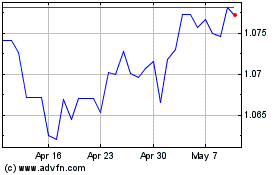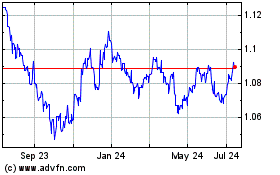EU Sees Eurozone Growth Gradually Easing Towards Potential
November 08 2018 - 3:27AM
RTTF2
Economic growth in the euro area is set to ease gradually
towards potential as the region does not display real signs of
overheating that could put an untimely end to growth, the European
Commission said in its Autumn forecast, published Thursday. In the
near term, economic growth is expected to continue at about the
same pace as in the first half of the year, resulting in euro area
growth of 2.1 percent in 2018, which was unchanged from the
previous projection.
Eurozone growth hit a decade-high of 2.4 percent in 2017.
Real GDP was forecast to grow 1.9 percent in 2019, which was
slower than the 2 percent projected earlier. Growth was seen at 1.7
percent in 2020.
"The European economy is holding up well, with growth easing
gradually," EU Economic Affairs Commissioner Pierre Moscovici
said.
"We project this pattern will continue over the next two years,
as unemployment continues to fall to levels not seen since before
the crisis."
According to the EU, trade tensions in emerging markets are
materializing. In Europe, uncertainty about the outlook for public
finances in Italy has led to higher interest spreads, and the
interaction of sovereign debt with the banking sector is still of
concern.
Further, the EU said the impact of a no-deal Brexit is expected
to be much larger on the UK than on the EU 27.
Italy's real GDP growth for this year was forecast at 1.1
percent. In 2019, a recovery of exports and higher public spending
will help lift real GDP to 1.2 percent, the EU said. For 2020,
growth is seen at 1.3 percent.
However, the report observed that the rise in the government
deficit, coupled with higher interest rates and substantial
downside risks, endangers the reduction of Italy's high debt-to-GDP
ratio.
UK GDP growth is currently subdued and expected to remain so
over the forecast horizon amid ongoing negotiation over the Brexit,
the EU said.
GDP growth is expected to remain weak at 1.2 percent in 2019,
marginally lower than the estimated 1.3 percent in 2018. Growth is
expected to be stable at 1.2 percent in 2020.
Germany's real GDP is expected to increase by 1.7 percent this
year, 1.8 percent in 2019 and 1.7 percent in 2020.
The EU forecast France's economic activity to accelerate in the
second half of 2018. The economy is forecast to expand 1.7 percent
in 2018, and 1.6 percent each next two years.
Spain's growth is expected to remain robust, but decelerate as
households restrain consumption to increase their savings. EU
projected 2.6 percent growth for 2018, 2.2 percent for 2019 and 2
percent for 2020.
Headline inflation in the euro area remains mainly driven by
developments in energy prices, the EU observed.
HICP inflation in the euro area was projected to rise to 1.8
percent in 2018 and in 2019 before moderating to 1.6 percent in
2020. In July, EU had forecast 1.7 percent inflation for both 2018
and 2019.
Euro vs US Dollar (FX:EURUSD)
Forex Chart
From Mar 2024 to Apr 2024

Euro vs US Dollar (FX:EURUSD)
Forex Chart
From Apr 2023 to Apr 2024
